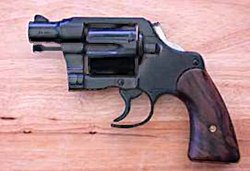FitzGerald Special
The Fitz Gerald Special, "Fitz Special", or "Fitz Colt" is a snubnosed revolver concept that was pioneered by John Henry Fitz Gerald (also known as "Fitz"), an employee of Colt Firearms from 1918 to 1944. Although historians disagree, it's believed that between 40 and 200 Fitz Specials left the factory, made from various Colt revolvers, by Fitzgerald himself.[1] The Fitz Special was the precursor of the modern snubnosed revolver and specifically the prototype for the Colt Detective Special.

Fitz Special
Fitz Special revolvers are made by taking any standard size Colt revolver, shortening the barrel to two inches, shortening the ejector rod, bobbing the hammer spur, rounding the butt, and removing the front half of the trigger guard. Reshaping the hammer and the butt allows the gun to be drawn quickly with little risk of the weapon snagging on clothing. The halved trigger guard facilitates quick trigger acquisition, even for shooters with large fingers or gloves. [2]
Although historians disagree, it's believe that somewhere between 40 and 200 Fitz Specials left the factory, made from various Colt revolvers, by Fitzgerald himself.[3] The Fitz Special was the precursor to the modern snubnosed revolver and specifically the prototype for the Colt Detective Special the first production two-inch snubnosed revolver. Even after the introduction of the Detective Special in 1927, Fitz continued to make custom revolvers for special clientele.
Colonels Rex Applegate[4] and Charles Askins were proponents of the Fitz Special.[5][6] Applegate himself carried a .45 ACP New Service Fitz Special with ivory handles that was even engraved with "TO REX FROM FITZ."[7] Askins called his .45 Colt New Service Fitz Special "The grandest defense gun I have ever had."[8] Charles Lindbergh, William Powell and Clyde Barrow were also known to carry Fitz Specials.[9] The Fitz Special would go on to become a popular after-market conversion for many gunsmiths.
John Henry Fitzgerald
Born in Keene, New Hampshire on 31 January 1876, John Henry Fitzgerald was a large, heavily built man with big hands, setting him apart from many others. During his younger days, Fitzgerald, or “Fitz,” as he was affectionately known, spent much of his time as a bare-knuckles prizefighter long before boxing gloves were used.
Developing an interest in firearms at an early age, Fitzgerald became a champion pistol shot, and he developed good relations with police officers he met. Fitz preferred Colt revolvers, especially the New Service, to all others and became quite adept at improving their actions by adjusting springs and smoothing and modifying internal parts. By 1918 he had become quite well known and was hired as a salesman by Colt Firearms."[10]
.jpg)
Fitzgerald developed his snubnosed revolver concept around the mid 1920s, when as an employee for Colt Firearms, he converted a .38 Special Colt Police Positive Special revolver, into his first Fitz Special.[11] He later converted two .45 Colt New Service revolvers in the same manner,[12] and was known to carry the pair in his front pockets.
Fitz was also a New York State Trooper, a police firearms instructor and a noted firearms expert. In 1930 he published a book titled Shooting, strongly advocating his snubnosed revolver concept as well as other topics of pistol shooting techniques and tactics. He developed the famous "Colt Police Silhouette Target" at a time when most shooters were still using bulls-eye targets and was strong and early advocate of "Practical Shooting"[13]
“Practical shooting is the placing of your bullets in the human body in such a manner that said human will be unable to shoot at you. The penalty for not being able to do this is the loss of your own life.”
— John Henry Fitzgerald
He was a strong proponent for the use of large caliber handguns, such as the .45 ACP Colt 1911 and was especially fond of using .45 Colt New Service revolvers.[14] He was among the first to advocate the two-handed shooting stance that was developed further by Jack Weaver and Jeff Cooper [15] beginning in the 1960s. His ideas would become the foundation of modern firearms training and influence generations of firearms instructors.
Fitzgerald died 26 June 1945 after retiring from Colt's the prior year and is buried in Rose Hill Memorial Park, Connecticut. His tombstone and other references including the 1920 Census indicate that he spelled his surname as two words: Fitzgerald.[16]
In popular culture
The character of NYPD Police Commissioner Frank Reagan, portrayed by the actor Tom Selleck, in the television series Blue Bloods, carries a Fitz Special revolver that was given to him by his father, Henry Reagan, NYPD Police Commissioner, retired, who also carried it "on the job" and had it given to him by his late father, who was also a career NYPD officer.
A Fitz Special also appears on the cover of the fifth James Bond novel, From Russia, with Love which was modeled after a gun provided by firearms expert and author Geoffrey Boothroyd (who was also a James Bond fan); Boothroyd advised Ian Fleming about the weapons used in the novels and would provide the inspiration for the character of Q. However, the revolver used in this instance differs from a true Fitz Special in that its hammer is intact.
Notes
- https://www.guns.com/news/2015/09/02/fitz-colt-snub-nosed-revolver-benchmark/ The Fitz Colt: The snub-nosed revolver benchmark 9/02/15 by Chris Eger
- FindArticles.com | CBSi
- https://www.guns.com/news/2015/09/02/fitz-colt-snub-nosed-revolver-benchmark/ The Fitz Colt: The snub-nosed revolver benchmark 9/02/15 by Chris Eger
- https://www.personaldefenseworld.com/2016/12/rex-applegate-fitz-special/ Perfect Fitz: Col. Rex Applegate’s One-of-a-Kind Fitz Special. COL. APPLEGATE'S FITZ SPECIAL IS TRULY A ONE-OF-A-KIND FIREARM WITH DEEP HISTORICAL SIGNIFICANCE. By MICHAEL JANICH
- https://www.guns.com/news/2015/09/02/fitz-colt-snub-nosed-revolver-benchmark/ The Fitz Colt: The snub-nosed revolver benchmark 9/02/15 by Chris Eger
- Taffin, John (2005). "Colt's New Service". American Handgunner. 30 (4): 109.
- https://www.personaldefenseworld.com/2016/12/rex-applegate-fitz-special/ Perfect Fitz: Col. Rex Applegate’s One-of-a-Kind Fitz Special. COL. APPLEGATE'S FITZ SPECIAL IS TRULY A ONE-OF-A-KIND FIREARM WITH DEEP HISTORICAL SIGNIFICANCE. By MICHAEL JANICH
- https://www.guns.com/news/2015/09/02/fitz-colt-snub-nosed-revolver-benchmark/ The Fitz Colt: The snub-nosed revolver benchmark. by Chris Eger. 9/02/15
- https://www.guns.com/news/2015/09/02/fitz-colt-snub-nosed-revolver-benchmark/ The Fitz Colt: The snub-nosed revolver benchmark 9/02/15 by Chris Eger
- https://www.americanrifleman.org/articles/2012/4/20/the-fitz-special/ The Fitz Special by Gary Paul Johnston, April 20, 2012
- https://www.americanrifleman.org/articles/2012/4/20/the-fitz-special/ The Fitz Special by Gary Paul Johnston, April 20, 2012
- "Archived copy". Archived from the original on 2010-07-17. Retrieved 2009-12-15.CS1 maint: archived copy as title (link)
- http://aimperfect.com/just-ramblin/2014/11/6/jh-fitzgerald
- http://aimperfect.com/just-ramblin/2014/11/6/jh-fitzgerald
- http://aimperfect.com/just-ramblin/2014/11/6/jh-fitzgerald
- Fitzgerald, John Henry. "J. Henry Fitzgerald". Find a Grave. Retrieved February 10, 2020.
References
- FitzGerald, J. H. (1930). Shooting. Hartford: The G.F. Book Co. OCLC 3549402. Riling 2081. Reprinted:
- FitzGerald, J. H. (2007). Shooting. Birmingham, Alabama: Paladin Press. ISBN 9781581606256. OCLC 884285114.
- Reference is to Riling, Ray (1951). Guns and Shooting: A Selected Chronological Bibliography; Including Works in Various Languages on Artillery, Bombs, Fireworks and Rockets. New York: Greenberg. OCLC 250358564.
